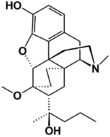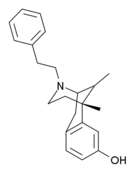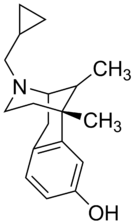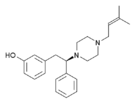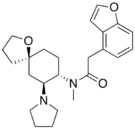Opioid
| Drug class | |

Harvesting the poppy pod.
|
|
| Class identifiers | |
|---|---|
| Use | pain relief |
| ATC code | N02A |
| Mode of action | opioid receptor |
| External links | |
| MeSH | D000701 |
Opioids are substances that act on opioid receptors to produce morphine-like effects.[1] Opioids are most often used medically to relieve pain.[2] Opioids include opiates, an older term that refers to such drugs derived from opium, including morphine itself.[3] Other opioids are semi-synthetic and synthetic drugs such as hydrocodone, oxycodone and fentanyl; antagonist drugs such as naloxone and endogenous peptides such as the endorphins.[4] The terms opiate and narcotic are sometimes encountered as synonyms for opioid. Opiate is properly limited to the natural alkaloids found in the resin of the opium poppy although some include semi-synthetic derivatives.[3][5] Narcotic, derived from words meaning numbness or sleep, as an American legal term, refers to cocaine and opioids, and their source materials; it is also loosely applied to any illegal or controlled psychoactive drug.[6][7] In other jurisdictions all controlled drugs are legally classified as narcotics. The term can have pejorative connotations and its use is generally discouraged where that is the case.[8][9]
Primarily used for pain relief, including anesthesia they are also used to suppress cough, suppress diarrhea, treat addiction, reverse opioid overdose, and suppress opioid induced constipation.[10] Extremely strong opioids are approved only for veterinary use such as immobilizing large mammals.[11] Opioids act by binding to opioid receptors, which are found principally in the central and peripheral nervous system and the gastrointestinal tract. These receptors mediate both the psychoactive and the somatic effects of opioids. Opioid drugs include partial agonists and antagonists, which produce moderate or no effect (respectively) but displace other opioids from binding in those receptors.
The side effects of opioids may include itchiness, sedation, nausea, respiratory depression, constipation, and euphoria. Tolerance and dependence will develop with continuous use, requiring increasing doses and leading to a withdrawal syndrome upon abrupt discontinuation. The euphoria attracts recreational use, and frequent, escalating recreational use of opioids typically results in addiction. Accidental overdose or concurrent use with other depressant drugs commonly results in death from respiratory depression.[12] Because of opioid drugs' reputation for addiction and fatal overdose, most are controlled substances.
Illicit production, smuggling, and addiction to opioids prompted treaties, laws and policing which have realized limited success. In 2013 between 28 and 38 million people used opioids illicitly (0.6% to 0.8% of the global population between the ages of 15 and 65).[13] In 2011 an estimated 4 million people in the United States used opioids recreationally or were dependent on them.[14] Current increased rates of recreational use and addiction are attributed to over-prescription of opioid medications and inexpensive illicit heroin.[15][16][17] Conversely, fears about over-prescribing, exaggerated side effects and addiction from opioids are similarly blamed for under-treatment of pain.[18][19]
Contents
- 1 Definition
- 2 Medical uses
- 3 Adverse effects
- 4 Interactions
- 5 Pharmacology
- 6 Usage
- 7 History
- 8 Society and culture
- 9 Classification
- 10 See also
- 11 References
- 12 External links
Definition[edit]
The term "opioid" originated in the 1950s.[20] It combines "opium" + "-oid" meaning "opiate-like" ("opiates" being morphine and similar drugs derived from opium). The first scientific publication to use it, in 1963, included a footnote stating, "In this paper, the term, 'opioid', is used in the sense originally proposed by George H. Acheson (personal communication) to refer to any chemical compound with morphine-like activities".[21] By the late 1960s, research found that opiate effects are mediated by activation of specific molecular receptors in the nervous system, which were termed "opioid receptors".[22] The definition of "opioid" was later refined to refer to substances that have morphine-like activities that are mediated by the activation of opioid receptors. One modern pharmacology textbook states: "the term opioid applies to all agonists and antagonists with morphine-like activity, and also the naturally occurring and synthetic opioid peptides".[23] Another pharmacology reference eliminates the morphine-like requirement: "Opioid, a more modern term, is used to designate all substances, both natural and synthetic, that bind to opioid receptors (including antagonists)".[1] Some sources define the term opioid to exclude opiates, and others use opiate comprehensively instead of opioid, but opioid used inclusively is considered modern, preferred and is in wide use.[3]
Medical uses[edit]
Pain[edit]
Opioids are indicated for the relief of mild[24] to severe pain, but are usually reserved for moderate to severe pain. The weak opioid codeine, in low doses and combined with one or more other drugs, is commonly available without a prescription.[25]
Acute pain[edit]
Opioids are effective for the treatment of acute pain (such as pain following surgery).[26] For immediate relief of moderate to severe acute pain opioids are frequently the treatment of choice due to their rapid onset, efficacy and reduced risk of dependence. They have also been found to be important in palliative care to help with the severe, chronic, disabling pain that may occur in some terminal conditions such as cancer, and degenerative conditions such as rheumatoid arthritis. In many cases opioids are a successful long-term care strategy for those with chronic cancer pain.
Chronic non-cancer pain[edit]
Guidelines have suggested that the risk of opioids is likely greater than their benefits when used for most non-cancer chronic conditions including headaches, back pain, and fibromyalgia.[27] Thus they should be used cautiously in chronic non-cancer pain.[28] If used the benefits and harms should be reassessed at least every three months.[29]
In treating chronic pain, opioids are an option to be tried after other less risky pain relievers have been considered, including paracetamol/acetaminophen or NSAIDs like ibuprofen or naproxen.[30] Some types of chronic pain, including the pain caused by fibromyalgia or migraine, are preferentially treated with drugs other than opioids.[31][32] The efficacy of using opioids to lessen chronic neuropathic pain is uncertain.[33]
Opioids are contraindicated as a first-line treatment for headache because they impair alertness, bring risk of dependence, and increase the risk that episodic headaches will become chronic.[34] Opioids can also cause heightened sensitivity to headache pain.[34] When other treatments fail or are unavailable, opioids may be appropriate for treating headache if the patient can be monitored to prevent the development of chronic headache.[34]
Opioids are being used more frequently in the management of non-malignant chronic pain.[35][36][37] This practice has now led to a new and growing problem with addiction and misuse of opioids.[28][38] Because of various negative effects the use of opioids for long term management of chronic pain is not indicated unless other less risky pain relievers have been found ineffective. Chronic pain which occurs only periodically, such as that from nerve pain, migraines, and fibromyalgia, frequently is better treated with medications other than opioids.[31] Paracetamol and non-steroidal anti-inflammatory drugs including ibuprofen and naproxen are considered safer alternatives.[39] They are frequently used combined with opioids, such as paracetamol combined with oxycodone (Percocet) and ibuprofen combined with hydrocodone (Vicoprofen), which boosts the pain relief but is also intended to deter recreational use.[40][41]
Other[edit]
Cough[edit]
Codeine was once viewed as the "gold standard" in cough suppressants, but this position is now questioned.[42] Some recent placebo-controlled trials have found that it may be no better than a placebo for some causes including acute cough in children.[43][44] Thus, it is not recommended for children.[44] Additionally, there is no evidence that hydrocodone is useful in children.[45] Similarly, a 2012 Dutch guideline regarding the treatment of acute cough does not recommend its use.[46] (The opioid analogue dextromethorphan, long claimed to be as effective a cough suppressant as codeine,[47] has similarly demonstrated little benefit in several recent studies.[48])
Low dose morphine may help chronic cough but its use is limited by side effects.[49]
Diarrhea and constipation[edit]
In cases of diarrhea-predominate irritable bowel syndrome, opioids may be used to suppress diarrhea. Loperamide is a peripherally selective opioid available without a prescription used to suppress diarrhea.
The ability to suppress diarrhea also produces constipation when opioids are used beyond several weeks.[50] Naloxegol, a peripherally-selective opioid antagonist is now available to treat opioid induced constipation.[51]
Shortness of breath[edit]
Opioids may help with shortness of breath particularly in advanced diseases such as cancer and COPD among others.[52][53]
Adverse effects[edit]
Common and short term
Other
- Cognitive effects
- Opioid dependence
- Dizziness
- Decreased sex drive
- Impaired sexual function
- Decreased testosterone levels
- Depression
- Immunodeficiency
- Increased pain sensitivity
- Irregular menstruation
- Increased risk of falls
- Slowed breathing
- Coma
Studies have shown opioids to be safe when they are used correctly and in the ways that are well understood.[55]
Carefully titrating the dose of opioids can provide for effective pain relief while minimizing adverse effects. Morphine and diamorphine have been shown to have a wider therapeutic range or "safety margin" than some other opioids. Because the required dose varies and can't be predicted, titration usually starts at low doses, increasing until the desired effect or adverse effects occur.[56]
Opioid analgesics do not cause any specific organ toxicity, unlike many other drugs, such as aspirin and paracetamol. They are not associated with upper gastrointestinal bleeding and renal toxicity.[57]
In older adults, opioid use is associated with increased adverse effects such as "sedation, nausea, vomiting, constipation, urinary retention, and falls".[58] As a result, older adults taking opioids are at greater risk for injury.[59]
Research suggests that when methadone is used long-term it can build up unpredictably in the body and lead to potentially deadly slowed breathing.[60][61] Used medically, approaching toxicity goes unrecognized because the pain medication effect ends long before the drug's elimination half-life.[62] According to the USCDC, methadone was involved in 31% of opioid related deaths in the US between 1999-2010 and 40% as the sole drug involved, far higher than other opioids.[63] Regular physician monitoring reduces the likelihood of problems.[60]
According to a cohort study, the rate of opioid related death was 0.017% per year amongst patients prescribed opioids for non-cancer pain from 1997 to 2005 in Washington State. Increasing dose and age were found to correlate with increased risk of overdose.[64] While a cohort study is a higher level of evidence than case-control, a case-control study done in Canada correlates well as it had an opioid related death rate of 0.024% per year amongst patients prescribed opioids for non-cancer pain over a 10-year period.[65]
-
Timeline of number of yearly U.S. overdose deaths involving prescription opioid pain relievers.[66]
-
Timeline of number of yearly U.S. overdose deaths involving heroin.[66]
Reinforcement disorders[edit]
Tolerance[edit]
Tolerance is a process characterized by neuroadaptations that result in reduced drug effects. While receptor upregulation may often play an important role other mechanisms are also known.[67] Tolerance is more pronounced for some effects than for others; tolerance occurs slowly to the effects on mood, itching, urinary retention, and respiratory depression, but occurs more quickly to the analgesia and other physical side effects. However, tolerance does not develop to constipation or miosis (the constriction of the pupil of the eye to less than or equal to two millimeters). This idea has been challenged, however, with some authors arguing that tolerance does develop to miosis.[68]
Tolerance to opioids is attenuated by a number of substances, including:
- calcium channel blockers[69][70][71]
- intrathecal magnesium[72][73] and zinc[74]
- NMDA antagonists, such as dextromethorphan, ketamine,[75] and memantine.[76]
- cholecystokinin antagonists, such as proglumide[77][78][79]
- Newer agents such as the phosphodiesterase inhibitor ibudilast have also been researched for this application.[80]
Tolerance is a physiologic process where the body adjusts to a medication that is frequently present, usually requiring higher doses of the same medication over time to achieve the same effect. It is a common occurrence in individuals taking high doses of opioids for extended periods, but does not predict any relationship to misuse or addiction.
Physical dependence[edit]
Physical dependence is the physiological adaptation of the body to the presence of a substance, in this case opioid medication. It is defined by the development of withdrawal symptoms when the substance is discontinued, when the dose is reduced abruptly or, specifically in the case of opioids, when an antagonist (e.g., naloxone) or an agonist-antagonist (e.g., pentazocine) is administered. Physical dependence is a normal and expected aspect of certain medications and does not necessarily imply that the patient is addicted.
The withdrawal symptoms for opiates may include severe dysphoria, craving for another opiate dose, irritability, sweating, nausea, rhinorrea, tremor, vomiting and myalgia. Slowly reducing the intake of opioids over days and weeks can reduce or eliminate the withdrawal symptoms.[56] The speed and severity of withdrawal depends on the half-life of the opioid; heroin and morphine withdrawal occur more quickly and are more severe than methadone withdrawal. The acute withdrawal phase is often followed by a protracted phase of depression and insomnia that can last for months. The symptoms of opioid withdrawal can be treated with other medications, such as clonidine.[81] Physical dependence does not predict drug misuse or true addiction, and is closely related to the same mechanism as tolerance. While there is anecdotal claims of benefit with ibogaine, data to support its use in substance dependence is poor.[82]
Addiction[edit]
Drug addiction is a complex set of behaviors typically associated with misuse of certain drugs, developing over time and with higher drug dosages. Addiction includes psychological compulsion, to the extent that the sufferer persists in actions leading to dangerous or unhealthy outcomes. Opioid addiction includes insufflation or injection, rather than taking opioids orally as prescribed for medical reasons.[56]
In European nations such as Austria, Bulgaria, and Slovakia, slow release oral morphine formulations are used in opiate substitution therapy (OST) for patients who do not well tolerate the side effects of buprenorphine or methadone. In other European countries including the UK, this is also legally used for OST although on a varying scale of acceptance.
Tamper-release formulations of time-controlled preparations of medications are intended to curb abuse and addiction rates while trying to still provide legitimate pain relief and ease of use to pain patients. Questions remain, however, about the efficacy and safety of these types of preparations. Further tamper resistant medications are currently under consideration with trials for market approval by the FDA.[83][84]
The amount of evidence available only permits making a weak conclusion, but it suggests that a physician properly managing opioid use in patients with no history of substance dependence or substance abuse can give long-term pain relief with little risk of developing addiction, abuse, or other serious side effects.[55]
Problems with opioids include the following:
- Some people find that opioids do not relieve all of their pain.[85]
- Some people find that opioids side effects cause problems which outweigh the therapy's benefit[55]
- Some people build tolerance to opioids over time. This requires them to increase their drug dosage to maintain the benefit, and that in turn also increases the unwanted side effects.[55]
- Long-term opioid use can cause opioid-induced hyperalgesia, which is a condition in which the patient has increased sensitivity to pain.[86]
All of the opioids can cause side effects.[54] Common adverse reactions in patients taking opioids for pain relief include nausea and vomiting, drowsiness, itching, dry mouth, dizziness, and constipation.[54][56]
Nausea and vomiting[edit]
Tolerance to nausea occurs within 7–10 days, during which antiemetics (e.g. low dose haloperidol once at night) are very effective.[citation needed] Due to severe side effects such as tardive dyskinesia, haloperidol is now rarely used. A related drug, prochlorperazine is more often used, although it has similar risks. Stronger antiemetics such as ondansetron or tropisetron are sometimes used when nausea is severe or continuous and disturbing, despite their greater cost. A less expensive alternative is dopamine antagonists such as domperidone and metoclopramide. Domperidone does not cross the blood–brain barrier and produce adverse central antidopaminergic effects, but blocks opioid emetic action in the chemoreceptor trigger zone. (The drug is not available in the U.S.) Some antihistamines with anticholinergic properties (e.g. orphenadrine or diphenhydramine) may also be effective. The first-generation antihistamine hydroxyzine is very commonly used, with the added advantages of not causing movement disorders, and also possessing analgesic-sparing properties. Δ9-tetrahydrocannabinol relieves nausea and vomiting;[87][88] it also produces analgesia that may allow lower doses of opioids with reduced nausea and vomiting.[89][90]
- 5-HT3 antagonists (e.g. ondansetron)
- Dopamine antagonists (e.g. domperidone)
- Anti-cholinergic antihistamines (e.g. diphenhydramine)
- Δ9-tetrahydrocannabinol (e.g. dronabinol)
Vomiting is due to gastric stasis (large volume vomiting, brief nausea relieved by vomiting, oesophageal reflux, epigastric fullness, early satiation), besides direct action on the chemoreceptor trigger zone of the area postrema, the vomiting centre of the brain. Vomiting can thus be prevented by prokinetic agents (e.g. domperidone or metoclopramide). If vomiting has already started, these drugs need to be administered by a non-oral route (e.g. subcutaneous for metoclopramide, rectally for domperidone).
- Prokinetic agents (e.g. domperidone)
- Anti-cholinergic agents (e.g. orphenadrine)
Drowsiness[edit]
Tolerance to drowsiness usually develops over 5–7 days, but if troublesome, switching to an alternative opioid often helps. Certain opioids such as fentanyl, morphine and diamorphine (heroin) tend to be particularly sedating, while others such as oxycodone, tilidine and meperidine (pethidine) tend to produce comparatively less sedation, but individual patients responses can vary markedly and some degree of trial and error may be needed to find the most suitable drug for a particular patient. Otherwise, treatment with CNS stimulants is generally effective.[91][92]
- Stimulants (e.g. caffeine, modafinil, amphetamine, methylphenidate)
Itching[edit]
Itching tends not to be a severe problem when opioids are used for pain relief, but antihistamines are useful for counteracting itching when it occurs. Non-sedating antihistamines such as fexofenadine are often preferred as they avoid increasing opioid induced drowsiness. However, some sedating antihistamines such as orphenadrine can produce a synergistic pain relieving effect permitting smaller doses of opioids be used. Consequently, several opioid/antihistamine combination products have been marketed, such as Meprozine (meperidine/promethazine) and Diconal (dipipanone/cyclizine), and these may also reduce opioid induced nausea.
- Antihistamines (e.g. fexofenadine)
Constipation[edit]
Opioid-induced constipation (OIC) develops in 90 to 95% of people taking opioids long-term.[93] Since tolerance to this problem does not develop readily, most people on long-term opioids will need a laxative.[94]
Treatment[edit]
Treatment of OIC is successional and dependent on severity.[95] The first mode of treatment is non-pharmacological, and includes lifestyle modifications like increasing dietary fiber, fluid intake (around 1.5 L (51 US fl oz) per day), and physical activity.[95] If non-pharmacological measures are ineffective, laxatives, including stool softeners (e.g., docusate), bulk-forming laxatives (e.g., fiber supplements), stimulant laxatives (e.g., bisacodyl, senna), and/or enemas, may be used.[95] A common laxative regimen for OIC is the combination of docusate and bisacodyl.[95][96][97] Osmotic laxatives, including lactulose, polyethylene glycol, and milk of magnesia (magnesium hydroxide), as well as mineral oil (a lubricant laxative), are also commonly used for OIC.[96][97]
If laxatives are insufficiently effective (which is often the case),[98] opioid formulations or regimens that include a peripherally-selective opioid antagonist, such as methylnaltrexone bromide, naloxegol, alvimopan, or naloxone (as in oxycodone/naloxone), may be tried.[95][97][99] A 2008 Cochrane review found that the evidence was tentative for alvimopan, naloxone, or methylnaltrexone bromide.[100]
Respiratory depression[edit]
Respiratory depression is the most serious adverse reaction associated with opioid use, but it usually is seen with the use of a single, intravenous dose in an opioid-naïve patient. In patients taking opioids regularly for pain relief, tolerance to respiratory depression occurs rapidly, so that it is not a clinical problem. Several drugs have been developed which can partially block respiratory depression, although the only respiratory stimulant currently approved for this purpose is doxapram, which has only limited efficacy in this application.[101][102] Newer drugs such as BIMU-8 and CX-546 may however be much more effective.[103][104][105]
- Respiratory stimulants: carotid chemoreceptor agonists (e.g. doxapram), 5-HT4 agonists (e.g. BIMU8), δ-opioid agonists (e.g. BW373U86) and AMPAkines (e.g. CX717) can all reduce respiratory depression caused by opioids without affecting analgesia, but most of these drugs are only moderately effective or have side effects which preclude use in humans. 5-HT1A agonists such as 8-OH-DPAT and repinotan also counteract opioid-induced respiratory depression, but at the same time reduce analgesia, which limits their usefulness for this application.
- Opioid antagonists (e.g. naloxone, nalmefene, diprenorphine)
Opioid-induced hyperalgesia[edit]
Opioid-induced hyperalgesia has been observed in some patients, whereby individuals using opioids to relieve pain may paradoxically experience more pain as a result of their medication. This phenomenon, although uncommon, is seen in some palliative care patients, most often when dose is escalated rapidly.[106][107] If encountered, rotation between several different opioid analgesics may mitigate the development of hyperalgesia.[108][109]
Side effects such as hyperalgesia and allodynia, sometimes accompanied by a worsening of neuropathic pain, may be consequences of long-term treatment with opioid analgesics, especially when increasing tolerance has resulted in loss of efficacy and consequent progressive dose escalation over time. This appears to largely be a result of actions of opioid drugs at targets other than the three classic opioid receptors, including the nociceptin receptor, sigma receptor and Toll-like receptor 4, and can be counteracted in animal models by antagonists at these targets such as J-113,397, BD-1047 or (+)-naloxone respectively.[110] No drugs are currently approved specifically for counteracting opioid-induced hyperalgesia in humans and in severe cases the only solution may be to discontinue use of opioid analgesics and replace them with non-opioid analgesic drugs. However, since individual sensitivity to the development of this side effect is highly dose dependent and may vary depending which opioid analgesic is used, many patients can avoid this side effect simply through dose reduction of the opioid drug (usually accompanied by addition of a supplemental non-opioid analgesic), rotating between different opioid drugs, or by switching to a milder opioid with mixed mode of action that also counteracts neuropathic pain, particularly tramadol or tapentadol.[111][112][113]
- NMDA antagonists such as ketamine
- SNRIs such as milnacipran
- anticonvulsants such as gabapentin or pregabalin
Other adverse effects[edit]
Hormone imbalance[edit]
Clinical studies have consistently associated medical and recreational opioid use with hypogonadism and hormone imbalance in different sexes. The effect is dose-dependent. Most studies suggest that the majority (perhaps as much as 90%) of chronic opioid users suffer hormone imbalances. Opioids can also interfere with menstruation in women by limiting the production of luteinizing hormone (LH). Opioid-induced endocrinopathy likely causes the strong association of opioid use with osteoporosis and bone fracture. It also may increase pain and thereby interfere with the intended clinical effect of opioid treatment. Opioid-induced endocrinopathy is likely caused their agonism of opioid receptors in the hypothalamus and the pituitary gland. One study found that the depressed testosterone levels of heroin addicts returned to normal within one month of abstinence, suggesting that the effect is not permanent.[citation needed] As of 2013[update], the effect of low-dose or acute opiate use on the endocrine system is unclear.[114][115][116]
Disruption of work[edit]
Use of opioids may be a risk factor for failing to return to work.[117][118]
Persons performing any safety-sensitive task should not use opioids.[119] Health care providers should not recommend that workers who drive or use heavy equipment including cranes or forklifts treat chronic or acute pain with opioids.[119] Workplaces which manage workers who perform safety-sensitive operations should assign workers to less sensitive duties for so long as those workers are treated by their physician with opioids.[119]
People who take opioids long term have increased likelihood of being unemployed.[120] Taking opioids further disrupts the patient's life and the adverse effects of opioids themselves can become a significant barrier to patients having an active life, gaining employment, and sustaining a career.
In addition, lack of employment may be a predictor of aberrant use of prescription opioids.[121]
Increased accident-proneness[edit]
Opioid use may increase accident-proneness. Opioids may increase risk of traffic accidents[122][123] and accidental falls.[124]
Rare side effects[edit]
Infrequent adverse reactions in patients taking opioids for pain relief include: dose-related respiratory depression (especially with more potent opioids), confusion, hallucinations, delirium, urticaria, hypothermia, bradycardia/tachycardia, orthostatic hypotension, dizziness, headache, urinary retention, ureteric or biliary spasm, muscle rigidity, myoclonus (with high doses), and flushing (due to histamine release, except fentanyl and remifentanil).[56] Both therapeutic and chronic use of opioids can compromise the function of the immune system. Opioids decrease the proliferation of macrophage progenitor cells and lymphocytes, and affect cell differentiation (Roy & Loh, 1996). Opioids may also inhibit leukocyte migration. However the relevance of this in the context of pain relief is not known.
Interactions[edit]
Physicians treating patients using opioids in combination with other drugs keep continual documentation that further treatment is indicated and remain aware of opportunities to adjust treatment if the patient's condition changes to merit less risky therapy.[125]
With other depressant drugs[edit]
The concurrent use of opioids with other depressant drugs such as benzodiazepines or ethanol increases the rates of adverse events and overdose.[125] As with an overdose of opioid alone, the combination of an opioid and another depressant may precipitate respiratory depression often leading to death.[126] These risks are lessened with close monitoring by a physician, who may conduct ongoing screening for changes in patient behavior and treatment compliance.[125]
Opioid antagonist[edit]
Finally, opioid effects (adverse or otherwise) can be reversed with an opioid antagonist such as naloxone or naltrexone.[127] These competitive antagonists bind to the opioid receptors with higher affinity than agonists but do not activate the receptors. This displaces the agonist, attenuating or reversing the agonist effects. However, the elimination half-life of naloxone can be shorter than that of the opioid itself, so repeat dosing or continuous infusion may be required, or a longer acting antagonist such as nalmefene may be used. In patients taking opioids regularly it is essential that the opioid is only partially reversed to avoid a severe and distressing reaction of waking in excruciating pain. This is achieved by not giving a full dose but giving this in small doses until the respiratory rate has improved. An infusion is then started to keep the reversal at that level, while maintaining pain relief. Opioid antagonists remain the standard treatment for respiratory depression following opioid overdose, with naloxone being by far the most commonly used, although the longer acting antagonist nalmefene may be used for treating overdoses of long-acting opioids such as methadone, and diprenorphine is used for reversing the effects of extremely potent opioids used in veterinary medicine such as etorphine and carfentanil. However, since opioid antagonists also block the beneficial effects of opioid analgesics, they are generally useful only for treating overdose, with use of opioid antagonists alongside opioid analgesics to reduce side effects, requiring careful dose titration and often being poorly effective at doses low enough to allow analgesia to be maintained.
Pharmacology[edit]
| Drug | Relative Potency [128] |
Nonionized Fraction |
Protein Binding |
Lipid Solubility [129][130] |
|---|---|---|---|---|
| Morphine | 1 | ++ | ++ | ++ |
| Meperidine | 0.1 | + | +++ | ++ |
| Hydromorphone | 10 | + | +++ | |
| Alfentanil | 10–25 | ++++ | ++++ | +++ |
| Fentanyl | 75–125 | + | +++ | ++++ |
| Remifentanil | 250 | +++ | +++ | ++ |
| Sufentanil | 500–1000 | ++ | ++++ | ++++ |
| Etorphine | 1000–3000 |
Opioids bind to specific opioid receptors in the nervous system and other tissues. There are three principal classes of opioid receptors, μ, κ, δ (mu, kappa, and delta), although up to seventeen have been reported, and include the ε, ι, λ, and ζ (Epsilon, Iota, Lambda and Zeta) receptors. Conversely, σ (Sigma) receptors are no longer considered to be opioid receptors because their activation is not reversed by the opioid inverse-agonist naloxone, they do not exhibit high-affinity binding for classical opioids, and they are stereoselective for dextro-rotatory isomers while the other opioid receptors are stereo-selective for levo-rotatory isomers. In addition, there are three subtypes of μ-receptor: μ1 and μ2, and the newly discovered μ3. Another receptor of clinical importance is the opioid-receptor-like receptor 1 (ORL1), which is involved in pain responses as well as having a major role in the development of tolerance to μ-opioid agonists used as analgesics. These are all G-protein coupled receptors acting on GABAergic neurotransmission.

The pharmacodynamic response to an opioid depends upon the receptor to which it binds, its affinity for that receptor, and whether the opioid is an agonist or an antagonist. For example, the supraspinal analgesic properties of the opioid agonist morphine are mediated by activation of the μ1 receptor; respiratory depression and physical dependence by the μ2 receptor; and sedation and spinal analgesia by the κ receptor[citation needed]. Each group of opioid receptors elicits a distinct set of neurological responses, with the receptor subtypes (such as μ1 and μ2 for example) providing even more [measurably] specific responses. Unique to each opioid is its distinct binding affinity to the various classes of opioid receptors (e.g. the μ, κ, and δ opioid receptors are activated at different magnitudes according to the specific receptor binding affinities of the opioid). For example, the opiate alkaloid morphine exhibits high-affinity binding to the μ-opioid receptor, while ketazocine exhibits high affinity to ĸ receptors. It is this combinatorial mechanism that allows for such a wide class of opioids and molecular designs to exist, each with its own unique effect profile. Their individual molecular structure is also responsible for their different duration of action, whereby metabolic breakdown (such as N-dealkylation) is responsible for opioid metabolism.
Functional selectivity[edit]
A new strategy of drug development takes receptor signal transduction into consideration. This strategy strives to increase the activation of desirable signalling pathways while reducing the impact on undesirable pathways. This differential strategy has been given several names, including functional selectivity and biased agonism. The first opioid that was intentionally designed as a biased agonist and placed into clinical evaluation is the drug oliceridine. It displays analgesic activity and reduced adverse effects.[132]
Opioid comparison[edit]
Extensive research has been conducted to determine equivalence ratios comparing the relative potency of opioids. Given a dose of an opioid, an equianalgesic table is used to find the equivalent dosage of another. Such tables are used in opioid rotation practices, and to describe an opioid by comparison to morphine, the reference opioid. Equianalgesic tables typically list drug half-lives, and sometimes equianalgesic doses of the same drug by means of administration, such as morphine: oral and intravenous.
Usage[edit]
| Substance | Best estimate |
Low estimate |
High estimate |
|---|---|---|---|
| Amphetamine- type stimulants |
35.65 | 15.34 | 55.90 |
| Cannabis | 182.50 | 127.54 | 233.65 |
| Cocaine | 18.26 | 14.88 | 22.08 |
| Ecstasy | 19.40 | 9.89 | 29.01 |
| Opiates | 17.44 | 13.74 | 21.59 |
| Opioids | 33.12 | 28.57 | 38.52 |
In the 1990s, opioid prescribing increased significantly. Once used almost exclusively for the treatment of acute pain or pain due to cancer, opioids are now prescribed liberally for people experiencing chronic pain. This has been accompanied by rising rates of accidental addiction and accidental overdoses leading to death. According to the International Narcotics Control Board, the United States and Canada lead the per capita consumption of prescription opioids.[134] The number of opioid prescriptions in the United States and Canada is double the consumption in the European Union, Australia, and New Zealand.[135] Certain populations have been affected by the opioid addiction crisis more than others, including First World communities[136] and low-income populations.[137] Public health specialists say that this may result from unavailability or high cost of alternative methods for addressing chronic pain.[138]
History[edit]
Opioids are among the world's oldest known drugs.[139][140] The medical, recreational, and religious use of the opium poppy predates the common era.[141] In the 19th century morphine was isolated and marketed,[142] and the hypodermic needle invented, introducing rapid, metered administration of the primary active compound.[141][143][144] Synthetic opioids were invented, and biological mechanisms discovered in the 20th century.[141]
Non-clinical use was criminalized in the United States by the Harrison Narcotics Tax Act of 1914, and by other laws worldwide. Since then, nearly all non-clinical use of opioids has been rated zero on the scale of approval of nearly every social institution. However, in United Kingdom the 1926 report of the Departmental Committee on Morphine and Heroin Addiction under the Chairmanship of the President of the Royal College of Physicians reasserted medical control and established the "British system" of control—which lasted until the 1960s; in the U.S. the Controlled Substances Act of 1970 markedly relaxed the harshness of the Harrison Act.
Before the twentieth century, institutional approval was often higher, even in Europe and America. In some cultures, approval of opioids was significantly higher than approval of alcohol. Opiates were used to treat depression and anxiety until the mid-1950s.[145]
Society and culture[edit]
Efforts to reduce abuse in the US[edit]
In 2011, the Obama administration released a white paper describing the administration's plan to deal with what it referred to as an epidemic of prescription drug abuse. The administration's concerns about addiction and accidental overdosing have been echoed by numerous other medical and government advisory groups around the world.[138][146][147][148]
As of 2015, prescription drug monitoring programs exist in every state but one. These programs allow pharmacists and prescribers to access patients’ prescription histories in order to identify suspicious use. However, a survey of US physicians published in 2015 found that only 53% of doctors used these programs, while 22% were not aware that the programs were available to them.[149] The Centers for Disease Control and Prevention was tasked with establishing and publishing a new guideline, and was heavily lobbied.[150] In 2016, the United States Centers for Disease Control and Prevention published its Guideline for Prescribing Opioids for Chronic Pain, recommending that opioids only be used when benefits for pain and function are expected to outweigh risks, and then used at the lowest effective dosage, with avoidance of concurrent opioid and benzodiazepine use whenever possible.[151]
Global shortages[edit]
Morphine and other poppy-based medicines have been identified by the World Health Organization as essential in the treatment of severe pain. As of 2002, seven countries (USA, UK, Italy, Australia, France, Spain and Japan) use 77% of the world's morphine supplies, leaving many emerging countries lacking in pain relief medication.[152] The current system of supply of raw poppy materials to make poppy-based medicines is regulated by the International Narcotics Control Board under the provision of the 1961 Single Convention on Narcotic Drugs. The amount of raw poppy materials that each country can demand annually based on these provisions must correspond to an estimate of the country's needs taken from the national consumption within the preceding two years. In many countries, underprescription of morphine is rampant because of the high prices and the lack of training in the prescription of poppy-based drugs. The World Health Organization is now working with administrations from various countries to train healthworkers and to develop national regulations regarding drug prescription to facilitate a greater prescription of poppy-based medicines.[153]
Another idea to increase morphine availability is proposed by the Senlis Council, who suggest, through their proposal for Afghan Morphine, that Afghanistan could provide cheap pain relief solutions to emerging countries as part of a second-tier system of supply that would complement the current INCB regulated system by maintaining the balance and closed system that it establishes while providing finished product morphine to those suffering from severe pain and unable to access poppy-based drugs under the current system.
Recreational use[edit]
Drug misuse is the use of drugs for reasons other than what the drug was prescribed for. Opioids are primarily misused due to their ability to produce strong euphoria.[154] Misuse can also include giving drugs to people for whom it was not prescribed or selling the medication, both of which are crimes punishable by imprisonment in some, if not most, countries.[155][156]
Classification[edit]
| This section needs additional citations for verification. (August 2011) (Learn how and when to remove this template message) |
There are a number of broad classes of opioids:
- Natural opiates: alkaloids contained in the resin of the opium poppy, primarily morphine, codeine, and thebaine, but not papaverine and noscapine which have a different mechanism of action; The following could be considered natural opiates: The leaves from Mitragyna speciosa (also known as kratom) contain a few naturally-occurring opioids, active via Mu- and Delta receptors. Salvinorin A, found naturally in the Salvia divinorum plant, is a kappa-opioid receptor agonist.
- Esters of morphine opiates: slightly chemically altered but more natural than the semi-synthetics, as most are morphine prodrugs, diacetylmorphine (morphine diacetate; heroin), nicomorphine (morphine dinicotinate), dipropanoylmorphine (morphine dipropionate), desomorphine, acetylpropionylmorphine, dibenzoylmorphine, diacetyldihydromorphine;[157][158]
- Semi-synthetic opioids: created from either the natural opiates or morphine esters, such as hydromorphone, hydrocodone, oxycodone, oxymorphone, ethylmorphine and buprenorphine;
- Fully synthetic opioids: such as fentanyl, pethidine, levorphanol, methadone, tramadol and dextropropoxyphene;
- Endogenous opioid peptides, produced naturally in the body, such as endorphins, enkephalins, dynorphins, and endomorphins. Morphine, and some other opioids, which are produced in small amounts in the body, are included in this category.
Tramadol and tapentadol, which act as monoamine uptake inhibitors also act as mild and potent agonists (respectively) of the μ-opioid receptor.[159] Both drugs produce analgesia even when naloxone, an opioid antagonist, is administered.[160]
Some minor opium alkaloids and various substances with opioid action are also found elsewhere, including molecules present in kratom, Corydalis, and Salvia divinorum plants and some species of poppy aside from Papaver somniferum. There are also strains which produce copious amounts of thebaine, an important raw material for making many semi-synthetic and synthetic opioids. Of all of the more than 120 poppy species, only two produce morphine.
Amongst analgesics there are a small number of agents which act on the central nervous system but not on the opioid receptor system and therefore have none of the other (narcotic) qualities of opioids although they may produce euphoria by relieving pain—a euphoria that, because of the way it is produced, does not form the basis of habituation, physical dependence, or addiction. Foremost amongst these are nefopam, orphenadrine, and perhaps phenyltoloxamine or some other antihistamines. Tricyclic antidepressants have painkilling effect as well, but they're thought to do so by indirectly activating the endogenous opioid system. Paracetamol is predominantly a centrally acting analgesic (non-narcotic) which mediates its effect by action on descending serotoninergic (5-hydroxy triptaminergic) pathways, to increase 5-HT release (which inhibits release of pain mediators). It also decreases cyclo-oxygenase activity. It has recently been discovered that most or all of the therapeutic efficacy of paracetamol is due to a metabolite ( AM404, making paracetamol a prodrug) which enhances the release of serotonin and also interacts with the cannabinoid receptors by inhibiting the uptake of anandamide.[citation needed]
Other analgesics work peripherally (i.e., not on the brain or spinal cord). Research is starting to show that morphine and related drugs may indeed have peripheral effects as well, such as morphine gel working on burns. Recent investigations discovered opioid receptors on peripheral sensory neurons.[161] A significant fraction (up to 60%) of opioid analgesia can be mediated by such peripheral opioid receptors, particularly in inflammatory conditions such as arthritis, traumatic or surgical pain.[162] Inflammatory pain is also blunted by endogenous opioid peptides activating peripheral opioid receptors.[163]
It has been discovered in 1953,[citation needed] that the human body, as well as those of some other animals, naturally produce minute amounts of morphine and codeine and possibly some of their simpler derivatives like heroin and dihydromorphine, in addition to the well known endogenous opioid peptides. Some bacteria are capable of producing some semi-synthetic opioids such as hydromorphone and hydrocodone when living in a solution containing morphine or codeine respectively.
Many of the alkaloids and other derivatives of the opium poppy are not opioids or narcotics; the best example is the smooth-muscle relaxant papaverine. Noscapine is a marginal case as it does have CNS effects but not necessarily similar to morphine, and it is probably in a category all its own.
Dextromethorphan (the stereoisomer of levomethorphan, a semi-synthetic opioid agonist) and its metabolite dextrorphan have no opioid analgesic effect at all despite their structural similarity to other opioids; instead they are potent NMDA antagonists and sigma 1 and 2-receptor agonists and are used in many over-the-counter cough suppressants.
Salvinorin A is a unique selective, powerful ĸ-opioid receptor agonist. It is not properly considered an opioid nevertheless, because:
- chemically, it is not an alkaloid; and
- it has no typical opioid properties: absolutely no anxiolytic or cough-suppressant effects. It is instead a powerful hallucinogen.
| Opioid peptides | Skeletal molecular images |
|---|---|
| Adrenorphin | 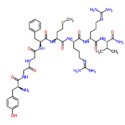 |
| Amidorphin |  |
| Casomorphin |  |
| DADLE | |
| DAMGO |  |
| Dermorphin | |
| Endomorphin |  |
| Morphiceptin |  |
| Nociceptin |  |
| Octreotide |  |
| Opiorphin |  |
| TRIMU 5 |  |
Endogenous opioids[edit]
Opioid-peptides that are produced in the body include:
β-endorphin is expressed in Pro-opiomelanocortin (POMC) cells in the arcuate nucleus, in the brainstem and in immune cells, and acts through μ-opioid receptors. β-endorphin has many effects, including on sexual behavior and appetite. β-endorphin is also secreted into the circulation from pituitary corticotropes and melanotropes. α-neo-endorphin is also expressed in POMC cells in the arcuate nucleus.
met-enkephalin is widely distributed in the CNS and in immune cells; [met]-enkephalin is a product of the proenkephalin gene, and acts through μ and δ-opioid receptors. leu-enkephalin, also a product of the proenkephalin gene, acts through δ-opioid receptors.
Dynorphin acts through κ-opioid receptors, and is widely distributed in the CNS, including in the spinal cord and hypothalamus, including in particular the arcuate nucleus and in both oxytocin and vasopressin neurons in the supraoptic nucleus.
Endomorphin acts through μ-opioid receptors, and is more potent than other endogenous opioids at these receptors.
Opium alkaloids and derivatives[edit]
Opium alkaloids[edit]
Phenanthrenes naturally occurring in (opium):
Preparations of mixed opium alkaloids, including papaveretum, are still occasionally used.
Esters of morphine[edit]
- Diacetylmorphine (morphine diacetate; heroin)
- Nicomorphine (morphine dinicotinate)
- Dipropanoylmorphine (morphine dipropionate)
- Diacetyldihydromorphine
- Acetylpropionylmorphine
- Desomorphine
- Methyldesorphine
- Dibenzoylmorphine
Ethers of morphine[edit]
Semi-synthetic alkaloid derivatives[edit]
Synthetic opioids[edit]
Anilidopiperidines[edit]
Phenylpiperidines[edit]
- Pethidine (meperidine)
- Ketobemidone
- MPPP
- Allylprodine
- Prodine
- PEPAP
- Promedol
Diphenylpropylamine derivatives[edit]
- Propoxyphene
- Dextropropoxyphene
- Dextromoramide
- Bezitramide
- Piritramide
- Methadone
- Dipipanone
- Levomethadyl Acetate (LAAM)
- Difenoxin
- Diphenoxylate
- Loperamide (does cross the blood-brain barrier but is quickly pumped into the non-central nervous system by P-Glycoprotein. Mild opiate withdrawal in animal models exhibits this action after sustained and prolonged use including rhesus monkeys, mice, and rats.)
Benzomorphan derivatives[edit]
- Dezocine—agonist/antagonist
- Pentazocine—agonist/antagonist
- Phenazocine
Oripavine derivatives[edit]
- Buprenorphine—partial agonist
- Dihydroetorphine
- Etorphine
Morphinan derivatives[edit]
- Butorphanol—agonist/antagonist
- Nalbuphine—agonist/antagonist
- Levorphanol
- Levomethorphan
Others[edit]
- Lefetamine
- Menthol (Kappa-Opioid agonist)
- Meptazinol
- Mitragynine
- Tilidine
- Tramadol
- Tapentadol
- Eluxadoline
Allosteric modulators[edit]
Plain allosteric modulators do not belong to the opioids, instead they are classified as opioidergics.
Opioid antagonists[edit]
Tables of opioids[edit]
Table of morphinan opioids[edit]
Table of non-morphinan opioids[edit]
| Table of non-morphinan opioids: click to | ||||||||||||||||||||||||||||||||||||||||||||||||||||||||||||||||||||||||||||||||||||||||||||||||||||||||||||||||||||||||||||||||||||||||||||||||||||||||||||||||||||||||||||||||||||||
|---|---|---|---|---|---|---|---|---|---|---|---|---|---|---|---|---|---|---|---|---|---|---|---|---|---|---|---|---|---|---|---|---|---|---|---|---|---|---|---|---|---|---|---|---|---|---|---|---|---|---|---|---|---|---|---|---|---|---|---|---|---|---|---|---|---|---|---|---|---|---|---|---|---|---|---|---|---|---|---|---|---|---|---|---|---|---|---|---|---|---|---|---|---|---|---|---|---|---|---|---|---|---|---|---|---|---|---|---|---|---|---|---|---|---|---|---|---|---|---|---|---|---|---|---|---|---|---|---|---|---|---|---|---|---|---|---|---|---|---|---|---|---|---|---|---|---|---|---|---|---|---|---|---|---|---|---|---|---|---|---|---|---|---|---|---|---|---|---|---|---|---|---|---|---|---|---|---|---|---|---|---|---|
|
||||||||||||||||||||||||||||||||||||||||||||||||||||||||||||||||||||||||||||||||||||||||||||||||||||||||||||||||||||||||||||||||||||||||||||||||||||||||||||||||||||||||||||||||||||||
See also[edit]
References[edit]
- ^ a b Hemmings, Hugh C.; Egan, Talmage D. (2013). Pharmacology and Physiology for Anesthesia: Foundations and Clinical Application: Expert Consult - Online and Print. Elsevier Health Sciences. p. 253. ISBN 1437716792.
Opiate is the older term classically used in pharmacology to mean a drug derived from opium. Opioid, a more modern term, is used to designate all substances, both natural and synthetic, that bind to opioid receptors (including antagonists).
- ^ Benzon, Honorio; Raja, Srinivasa N.; Fishman, Scott E.; Liu, Spencer; Cohen, Steven P. (2011). Essentials of Pain Medicine. Elsevier Health Sciences. p. 85. ISBN 1437735932.
- ^ a b c Offermanns, Stefan (2008). Encyclopedia of Molecular Pharmacology. 1 (2 ed.). Springer Science & Business Media. p. 903. ISBN 9783540389163.
In the strict sense, opiates are drugs derived from opium and include the natural products morphine, codeine, thebaine and many semi-synthetic congeners derived from them. In the wider sense, opiates are morphine-like drugs with non peptidic structures. The older term opiates is now more and more replaced by the term opioids which applies to any substance, whether endogenous or synthetic, peptidic or non-peptidic, that produces morphine-like effects through action on opioid receptors.
- ^ Freye, Enno (2008). "Part II. Mechanism of action of opioids and clinical effects". Opioids in Medicine: A Comprehensive Review on the Mode of Action and the Use of Analgesics in Different Clinical Pain States. Springer Science & Business Media. p. 85. ISBN 9781402059476.
Opiate is a specific term that is used to describe drugs (natural and semi-synthetic) derived from the juice of the opium poppy. For example morphine is an opiate but methadone (a completely synthetic drug) is not. Opioid is a general term that includes naturally occurring, semi-synthetic, and synthetic drugs, which produce their effects by combining with opioid receptors and are competitively antagonized by nalaxone. In this context the term opioid refers to opioid agonists, opioid antagonists, opioid peptides, and opioid receptors.
- ^ ARNP, Pamela Davies MS; CNS, Yvonne D'Arcy MS, CRNP (2012-09-26). Compact Clinical Guide to Cancer Pain Management: An Evidence-Based Approach for Nurses. Springer Publishing Company. ISBN 9780826109743.
- ^ "21 U.S. Code § 802 - Definitions". LII / Legal Information Institute. Retrieved 2016-02-12.
- ^ "Definition of NARCOTIC". www.merriam-webster.com. Retrieved 2016-02-12.
- ^ Satoskar, R. S.; Rege, Nirmala; Bhandarkar, S. D. (2015). Pharmacology and Pharmacotherapeutics. Elsevier Health Sciences. ISBN 9788131243718.
- ^ Ebert, Michael H.; Kerns, Robert D. (2010). Behavioral and Psychopharmacologic Pain Management. Cambridge University Press. ISBN 9781139493543.
- ^ Stromgaard, Kristian; Krogsgaard-Larsen, Povl; Madsen, Ulf (2009). Textbook of Drug Design and Discovery, Fourth Edition. CRC Press. ISBN 9781439882405.
- ^ Sterken, Joeri; Troubleyn, Joris; Gasthuys, Frank; Maes, Viviane; Diltoer, Mark; Verborgh, Christian (2004-10-01). "Intentional overdose of Large Animal Immobilon". European Journal of Emergency Medicine. 11 (5): 298–301. doi:10.1097/00063110-200410000-00013. ISSN 0969-9546. PMID 15359207.
- ^ "FDA requires strong warnings for opioid analgesics, prescription opioid cough products, and benzodiazepine labeling related to serious risks and death from combined use". FDA. August 31, 2016. Retrieved 1 September 2016.
- ^ "Status and Trend Analysis of Illict [sic] Drug Markets". World Drug Report 2015 (PDF). Retrieved 26 June 2015.
- ^ "Report III: FDA Approved Medications for the Treatment of Opiate Dependence: Literature Reviews on Effectiveness & Cost- Effectiveness, Treatment Research Institute". Advancing Access to Addiction Medications: Implications for Opioid Addiction Treatment. p. 41.
- ^ Tetrault, Jeanette M.; Butner, Jenna L. (2015-09-03). "Non-Medical Prescription Opioid Use and Prescription Opioid Use Disorder: A Review". The Yale Journal of Biology and Medicine. 88 (3): 227–233. ISSN 0044-0086. PMC 4553642
 . PMID 26339205.
. PMID 26339205. - ^ Tarabar, Asim F.; Nelson, Lewis S. (2003-04-01). "The resurgence and abuse of heroin by children in the United States". Current Opinion in Pediatrics. 15 (2): 210–215. doi:10.1097/00008480-200304000-00013. ISSN 1040-8703. PMID 12640281.
- ^ Gray, Eliza (2014-02-04). "Heroin Gains Popularity as Cheap Doses Flood the U.S.". TIME.com. Retrieved 2016-02-12.
- ^ Maltoni, M. (2008-01-01). "Opioids, pain, and fear". Annals of Oncology. 19 (1): 5–7. doi:10.1093/annonc/mdm555. ISSN 0923-7534. PMID 18073220.
[A] number of studies, however, have also reported inadequate pain control in 40%–70% of patients, resulting in the emergence of a new type of epidemiology, that of ‘failed pain control’, caused by a series of obstacles preventing adequate cancer pain management.... The cancer patient runs the risk of becoming an innocent victim of a war waged against opioid abuse and addiction if the norms regarding the two kinds of use (therapeutic or nontherapeutic) are not clearly distinct. Furthermore, health professionals may be worried about regulatory scrutiny and may opt not to use opioid therapy for this reason.
- ^ McCarberg, Bill H. (2011-03-01). "Pain management in primary care: strategies to mitigate opioid misuse, abuse, and diversion". Postgraduate Medicine. 123 (2): 119–130. doi:10.3810/pgm.2011.03.2270. ISSN 1941-9260. PMID 21474900.
- ^ "opioid: definition of opioid in Oxford dictionary (American English) (US)". www.oxforddictionaries.com. Retrieved 2016-02-14.
Opioid: 1950s: from opium + -oid.
- ^ Wikler, A.; Martin, W. R.; Pescor, F. T.; Eades, C. G. (1963-10-24). "Factors regulating oral consumption of an opioid (etonitazene) by morphine-addicted rats". Psychopharmacologia. 5: 55–76. doi:10.1007/bf00405575. PMID 14082382.
In this paper, the term, 'opioid', is used in the sense originally proposed by DR. GEORGE H. ACHESON (personal communication) to refer to any chemical compound with morphine-like activities.
- ^ Martin WR (1967). "Opioid antagonists". Pharmacol. Rev. 19 (4): 463–521. PMID 4867058.
- ^ Mehdi B (2008). "Opioid analgesics and antagonists". In Seth SD, Seth V. Textbook Of Pharmacology. Elsevier India. p. III.137. ISBN 9788131211588.
- ^ Fleisher, Gary R.; Ludwig, Stephen (2010). Textbook of Pediatric Emergency Medicine. Lippincott Williams & Wilkins. p. 61. ISBN 9781605471594.
- ^ Moore, R. Andrew; Wiffen, Philip J.; Derry, Sheena; Maguire, Terry; Roy, Yvonne M.; Tyrrell, Laila (2015). "Non-prescription (OTC) oral analgesics for acute pain - an overview of Cochrane reviews". The Cochrane Database of Systematic Reviews. 11: CD010794. doi:10.1002/14651858.CD010794.pub2. ISSN 1469-493X. PMID 26544675.
- ^ Alexander GC, Kruszewski SP, Webster DW (2012). "Rethinking Opioid Prescribing to Protect Patient Safety and Public Health". JAMA. 308 (18): 1865–1866. doi:10.1001/jama.2012.14282. PMID 23150006.
- ^ Franklin, G. M. (29 September 2014). "Opioids for chronic noncancer pain: A position paper of the American Academy of Neurology". Neurology. 83 (14): 1277–1284. doi:10.1212/WNL.0000000000000839. PMID 25267983.
- ^ a b Okie S (November 2010). "A flood of opioids, a rising tide of deaths". N. Engl. J. Med. 363 (21): 1981–5. doi:10.1056/NEJMp1011512. PMID 21083382.
Responses to Okie's perspective: "Opioids and deaths". N. Engl. J. Med. 364 (7): 686–7. February 2011. doi:10.1056/NEJMc1014490. - ^ Dowell, D; Haegerich, TM; Chou, R (19 April 2016). "CDC Guideline for Prescribing Opioids for Chronic Pain--United States, 2016.". JAMA. 315 (15): 1624–45. doi:10.1001/jama.2016.1464. PMID 26977696.
- ^ McNicol E, Strassels SA, Goudas L, Lau J, Carr DB (2005). "NSAIDS or paracetamol, alone or combined with opioids, for cancer pain". Cochrane Database Syst Rev (1): CD005180. doi:10.1002/14651858.CD005180. PMID 15654708.
- ^ a b For information on the use and overuse of opioids to treat migraines, see American Academy of Neurology (February 2013), "Five Things Physicians and Patients Should Question", Choosing Wisely: an initiative of the ABIM Foundation, American Academy of Neurology, retrieved 1 August 2013, which cites
- Silberstein SD (2000). "Practice parameter: Evidence-based guidelines for migraine headache (an evidence-based review): Report of the Quality Standards Subcommittee of the American Academy of Neurology". Neurology. 55 (6): 754–762. doi:10.1212/WNL.55.6.754. PMID 10993991.
- Evers S, Afra J, Frese A, Goadsby PJ, Linde M, May A, Sándor PS (2009). "EFNS guideline on the drug treatment of migraine - revised report of an EFNS task force". European Journal of Neurology. 16 (9): 968–981. doi:10.1111/j.1468-1331.2009.02748.x. PMID 19708964.
- Institute for Clinical Systems Improvement (2011), Headache, Diagnosis and Treatment of, Institute for Clinical Systems Improvement
- ^ Painter JT, Crofford LJ (2013). "Chronic Opioid Use in Fibromyalgia Syndrome". Journal of Clinical Rheumatology. 19 (2): 72–77. doi:10.1097/RHU.0b013e3182863447. PMID 23364665.
- ^ McNicol ED, Midbari A, Eisenberg E (2013). "Opioids for neuropathic pain". Cochrane Database Syst Rev. 8: CD006146. doi:10.1002/14651858.CD006146.pub2. PMID 23986501.
- ^ a b c American Headache Society (September 2013), "Five Things Physicians and Patients Should Question", Choosing Wisely: an initiative of the ABIM Foundation, American Headache Society, retrieved 10 December 2013, which cites
- Bigal ME, Lipton RB (2009). "Excessive opioid use and the development of chronic migraine". Pain. 142 (3): 179–182. doi:10.1016/j.pain.2009.01.013. PMID 19232469.
- Bigal ME, Serrano D, Buse D, Scher A, Stewart WF, Lipton RB (2008). "Acute Migraine Medications and Evolution from Episodic to Chronic Migraine: A Longitudinal Population-Based Study". Headache: the Journal of Head and Face Pain. 48 (8): 1157–1168. doi:10.1111/j.1526-4610.2008.01217.x. PMID 18808500.
- Scher AI, Stewart WF, Ricci JA, Lipton RB (2003). "Factors associated with the onset and remission of chronic daily headache in a population-based study". Pain. 106 (1–2): 81–89. doi:10.1016/S0304-3959(03)00293-8. PMID 14581114.
- Katsarava Z, Schneeweiss S, Kurth T, Kroener U, Fritsche G, Eikermann A, Diener HC, Limmroth V (2004). "Incidence and predictors for chronicity of headache in patients with episodic migraine". Neurology. 62 (5): 788–790. doi:10.1212/01.WNL.0000113747.18760.D2. PMID 15007133.
- ^ "Opioid epidemic in the United States.". Pain Physician. 15 (3 Suppl): ES9–38. Jul 2012. PMID 22786464.
- ^ http://www.jpain.org/article/S1526-5900(08)00830-4/abstract
- ^ "PAIN". Painjournalonline.com. 2015-09-01. Retrieved 2016-01-07.
- ^ Kissin I (2015-09-28). "Long-term opioid treatment of chronic nonmalignant pain: unproven efficacy and neglected safety?". J Pain Res. 6: 513–29. doi:10.2147/JPR.S47182. PMC 3712997
 . PMID 23874119.
. PMID 23874119. - ^ Dhalla, Irfan A.; Gomes, Tara; Mamdani, Muhammad M.; Juurlink, David N. (2012). "Opioids versus nonsteroidal anti-inflammatory drugs in noncancer pain". Canadian Family Physician. 58 (1): 30. ISSN 0008-350X. PMC 3264005
 . PMID 22267615.
. PMID 22267615. - ^ Marret, E.; Beloeil, H.; Lejus, C. (2009). "[What are the benefits and risk of non-opioid analgesics combined with postoperative opioids?]". Annales Françaises D'anesthèsie Et De Rèanimation. 28 (3): e135–151. doi:10.1016/j.annfar.2009.01.006. ISSN 1769-6623. PMID 19304445.
- ^ Franceschi, F.; Iacomini, P.; Marsiliani, D.; Cordischi, C.; Antonini, E. Forte S.; Alesi, A.; Giacobelli, D.; Zuccalà, G. (2013). "Safety and efficacy of the combination acetaminophen-codeine in the treatment of pain of different origin" (pdf). European Review for Medical and Pharmacological Sciences. 17 (16): 2129–2135. ISSN 1128-3602. PMID 23893177.
- ^ ed, Kian Fan Chung ... (2008). Pharmacology and therapeutics of cough. Berlin: Springer. p. 248. ISBN 9783540798422.
- ^ Bolser DC, Davenport PW (February 2007). "Codeine and cough: an ineffective gold standard". Current Opinion in Allergy and Clinical Immunology. 7 (1): 32–6. doi:10.1097/ACI.0b013e3280115145. PMC 2921574
 . PMID 17218808.
. PMID 17218808. - ^ a b Goldman, RD (Dec 2010). "Codeine for acute cough in children". Canadian Family Physician. 56 (12): 1293–4. PMC 3001921
 . PMID 21156892.
. PMID 21156892. - ^ Paul, IM (Feb 2012). "Therapeutic options for acute cough due to upper respiratory infections in children.". Lung. 190 (1): 41–4. doi:10.1007/s00408-011-9319-y. PMID 21892785.
- ^ Verlee, L; Verheij, TJ; Hopstaken, RM; Prins, JM; Salomé, PL; Bindels, PJ (2012). "[Summary of NHG practice guideline 'Acute cough'].". Nederlands tijdschrift voor geneeskunde. 156 (0): A4188. PMID 22917039.
- ^ Matthys, H.; Bleicher, B.; Bleicher, U. (1983). "Dextromethorphan and codeine: objective assessment of antitussive activity in patients with chronic cough". The Journal of International Medical Research. 11 (2): 92–100. doi:10.1177/030006058301100206. ISSN 0300-0605. PMID 6852361.
- ^ Van Amburgh, Jenny A. "Do Cough Remedies Work?". Medscape. Retrieved 10 April 2016.
- ^ Bolser, Donald C. (2010-02-01). "Pharmacologic Management of Cough". Otolaryngologic clinics of North America. 43 (1): 147–155. doi:10.1016/j.otc.2009.11.008. ISSN 0030-6665. PMC 2827356
 . PMID 20172264.
. PMID 20172264. - ^ Webster, Lynn R. (2015-10-01). "Opioid-Induced Constipation". Pain Medicine (Malden, Mass.). 16 Suppl 1: S16–21. doi:10.1111/pme.12911. ISSN 1526-4637. PMID 26461071.
- ^ "Press Announcements - FDA approves Movantik for opioid-induced constipation". www.fda.gov. Retrieved 2016-02-18.
- ^ Gallagher R (2011). "The use of opioids for dyspnea in advanced disease". Canadian Medical Association Journal. 183 (10): 1170. doi:10.1503/cmaj.110024. PMID 21482650.
- ^ Wiseman, R; Rowett, D; Allcroft, P; Abernethy, A; Currow, DC (Mar 2013). "Chronic refractory dyspnoea--evidence based management.". Australian family physician. 42 (3): 137–40. PMID 23529525.
- ^ a b c d e f g h Furlan AD, Sandoval JA, Mailis-Gagnon A, Tunks E (2006). "Opioids for chronic noncancer pain: A meta-analysis of effectiveness and side effects". Canadian Medical Association Journal. 174 (11): 1589–1594. doi:10.1503/cmaj.051528. PMC 1459894
 . PMID 16717269.
. PMID 16717269. - ^ a b c d Noble, M.; Treadwell, J. R.; Tregear, S. J.; Coates, V. H.; Wiffen, P. J.; Akafomo, C.; Schoelles, K. M. (2010). Noble, Meredith, ed. "Long-term opioid management for chronic noncancer pain". Cochrane Database of Systematic Reviews. doi:10.1002/14651858.CD006605.pub2.
- ^ a b c d e Doyle, D.; Hanks, G.; Cherney, I.; et al., eds. (2004). Oxford Textbook of Palliative Medicine (3rd ed.). Oxford University Press. ISBN 0198566980.
- ^ Schneider JP. Rational use of opioid analgesics in chronic musculoskeletal pain. J Musculoskel Med. 2010;27:142-148.
- ^ Baumann S (2009). "A nursing approach to pain in older adults". Medsurg Nurs. 18 (2): 77–82; quiz 83. PMID 19489204.
- ^ Buckeridge D, Huang A, Hanley J, Kelome A, Reidel K, Verma A, Winslade N, Tamblyn R (September 2010). "Risk of injury associated with opioid use in older adults". J Am Geriatr Soc. 58 (9): 1664–70. doi:10.1111/j.1532-5415.2010.03015.x. PMID 20863326.
- ^ a b Wolff K (2002). "Characterization of methadone overdose: Clinical considerations and the scientific evidence". Therapeutic drug monitoring. 24 (4): 457–70. doi:10.1097/00007691-200208000-00001. PMID 12142628.
- ^ Teichtahl H, Wang D (2007). "Sleep-disordered breathing with chronic opioid use". Expert Opinion on Drug Safety. 6 (6): 641–9. doi:10.1517/14740338.6.6.641. PMID 17967153.
- ^ Center for Drug Evaluation and Research (23 August 2013). "Postmarket Drug Safety Information for Patients and Providers - Information for Healthcare Professionals Methadone Hydrochloride". U.S. Food and Drug Administration. Retrieved 24 February 2016.
Methadone’s elimination half-life (8-59 hours) is longer than its duration of analgesic action (4-8 hours).
- ^ Stephens, Everett (23 November 2015). "Opioid Toxicity". Medscape. Retrieved 24 February 2016.
The CDC reported that methadone contributed to 31.4% of opioid-related deaths in the United States from 1999-2010. Methadone also accounted for 39.8% of all single-drug opioid-related deaths. The overdose death rate associated with methadone was significantly higher than that associated with other opioid-related deaths among multidrug and single-drug deaths.
- ^ Dunn KM, Saunders KW, Rutter CM, Banta-Green CJ, Merrill JO, Sullivan MD, Weisner CM, Silverberg MJ, Campbell CI, Psaty BM, Von Korff M (January 2010). "Opioid prescriptions for chronic pain and overdose: a cohort study". Ann Intern Med. 152 (2): 85–92. doi:10.1059/0003-4819-152-2-201001190-00006. PMC 3000551
 . PMID 20083827.
. PMID 20083827. - ^ Gomes T, Mamdani MM, Dhalla IA, Paterson JM, Juurlink DN (April 2011). "Opioid dose and drug-related mortality in patients with nonmalignant pain". Arch Intern Med. 171 (7): 686–91. doi:10.1001/archinternmed.2011.117. PMID 21482846.
- ^ a b Overdose Death Rates. By National Institute on Drug Abuse (NIDA).
- ^ Pradhan; et al. (2010). "Ligand-directed trafficking of the δ-opioid receptor in vivo: two paths toward analgesic tolerance.". J Neurosci. 30 (49): 16459–68. doi:10.1523/JNEUROSCI.3748-10.2010. PMID 21147985.
- ^ Kollars JP, Larson MD (March 2005). "Tolerance to miotic effects of opioids". Anesthesiology. 102 (3): 701. doi:10.1097/00000542-200503000-00047. PMID 15731628.
- ^ Santillán R, Maestre JM, Hurlé MA, Flórez J (Jul 1994). "Enhancement of opiate analgesia by nimodipine in cancer patients chronically treated with morphine: a preliminary report". Pain. 58 (1): 129–32. doi:10.1016/0304-3959(94)90192-9. PMID 7970835.
- ^ Santillán R1, Hurlé MA, Armijo JA, de los Mozos R, Flórez J. (May 1998). "Nimodipine-enhanced opiate analgesia in cancer patients requiring morphine dose escalation: a double-blind, placebo-controlled study.". Pain. 76 (1-2): 17–26. doi:10.1016/S0304-3959(98)00019-0. PMID 9696455.
- ^ Smith FL, Dombrowski DS, Dewey WL (Feb 1999). "Involvement of intracellular calcium in morphine tolerance in mice". Pharmacology, Biochemistry, and Behavior. 62 (2): 381–8. doi:10.1016/S0091-3057(98)00168-3. PMID 9972707.
- ^ McCarthy RJ, Kroin JS, Tuman KJ, Penn RD, Ivankovich AD (Apr 1998). "Antinociceptive potentiation and attenuation of tolerance by intrathecal co-infusion of magnesium sulfate and morphine in rats". Anesthesia and Analgesia. 86 (4): 830–6. doi:10.1097/00000539-199804000-00028. PMID 9539610.
- ^ Morrison AP1, Hunter JM, Halpern SH, Banerjee A. (May 2013). "Effect of intrathecal magnesium in the presence or absence of local anaesthetic with and without lipophilic opioids: a systematic review and meta-analysis.". British Journal of Anaesthesia. 110 (5): 702–12. doi:10.1093/bja/aet064. PMID 23533255.
- ^ Larson AA, Kovács KJ, Spartz AK (Nov 2000). "Intrathecal Zn2+ attenuates morphine antinociception and the development of acute tolerance". European Journal of Pharmacology. 407 (3): 267–72. doi:10.1016/S0014-2999(00)00715-9. PMID 11068022.
- ^ Wong CS, Cherng CH, Luk HN, Ho ST, Tung CS (February 1996). "Effects of NMDA receptor antagonists on inhibition of morphine tolerance in rats: binding at mu-opioid receptors". Eur. J. Pharmacol. 297 (1–2): 27–33. doi:10.1016/0014-2999(95)00728-8. PMID 8851162.
- ^ Malec D, Mandryk M, Fidecka S (Mar–Apr 2008). "Interaction of memantine and ketamine in morphine- and pentazocine-induced antinociception in mice" (PDF). Pharmacological Reports. 60 (2): 149–55. PMID 18443375. Retrieved 17 September 2011.
- ^ McCleane GJ (2003). "The cholecystokinin antagonist proglumide enhances the analgesic effect of dihydrocodeine". Clin J Pain. 19 (3): 200–1. doi:10.1097/00002508-200305000-00008. PMID 12792559.
- ^ Watkins LR, Kinscheck IB, Mayer DJ (Apr 1984). "Potentiation of opiate analgesia and apparent reversal of morphine tolerance by proglumide". Science. 224 (4647): 395–6. doi:10.1126/science.6546809. PMID 6546809.
- ^ Tang J, Chou J, Iadarola M, Yang HY, Costa E (Jun 1984). "Proglumide prevents and curtails acute tolerance to morphine in rats". Neuropharmacology. 23 (6): 715–8. doi:10.1016/0028-3908(84)90171-0. PMID 6462377.
- ^ Ledeboer A, Hutchinson MR, Watkins LR, Johnson KW (Jul 2007). "Ibudilast (AV-411). A new class therapeutic candidate for neuropathic pain and opioid withdrawal syndromes". Expert Opinion on Investigational Drugs. 16 (7): 935–50. doi:10.1517/13543784.16.7.935. PMID 17594181.
- ^ Hermann D, Klages E, Welzel H, Mann K, Croissant B (June 2005). "Low efficacy of non-opioid drugs in opioid withdrawal symptoms". Addict Biol. 10 (2): 165–9. doi:10.1080/13556210500123514. PMID 16191669.
- ^ Brown, TK (March 2013). "Ibogaine in the treatment of substance dependence.". Current drug abuse reviews. 6 (1): 3–16. doi:10.2174/15672050113109990001. PMID 23627782.
- ^ Bannwarth B (10 September 2012). "Will abuse deterrent formulations of opioid analgesics be successful in their purpose?". Drugs. 72 (12): 1713–1723. doi:10.2165/11635860-000000000-00000. PMID 22931520.
- ^ Schneider JP, Matthews M, Jamison RN (24 Oct 2010). "Abuse-deterrent and tamper-resistant opioid formulations: what is their role in addressing prescription opioid abuse?". CNS Drugs. 10 (80): 805–810. doi:10.2165/11584260-000000000-00000. PMID 20839893.
- ^ Xu Y, Johnson A (2013). "Opioid Therapy Pharmacogenomics for Noncancer Pain: Efficacy, Adverse Events, and Costs". Pain Research and Treatment. 2013: 1–8. doi:10.1155/2013/943014. PMC 3791560
 . PMID 24167729.
. PMID 24167729. - ^ Brush DE (2012). "Complications of Long-Term Opioid Therapy for Management of Chronic Pain: The Paradox of Opioid-Induced Hyperalgesia". Journal of Medical Toxicology. 8 (4): 387–392. doi:10.1007/s13181-012-0260-0. PMC 3550256
 . PMID 22983894.
. PMID 22983894. - ^ Malik, Zubair; Baik, Daniel; Schey, Ron (2015). "The role of cannabinoids in regulation of nausea and vomiting, and visceral pain". Current Gastroenterology Reports. 17 (2): 429. doi:10.1007/s11894-015-0429-1. ISSN 1534-312X. PMID 25715910.
- ^ Abrams, D. I.; Guzman, M. (2015). "Cannabis in cancer care". Clinical Pharmacology and Therapeutics. 97 (6): 575–586. doi:10.1002/cpt.108. ISSN 1532-6535. PMID 25777363.
- ^ "UCSF Study Finds Medical Marijuana Could Help Patients Reduce Pain with Opiates". UC San Francisco. Retrieved 2016-03-04.
- ^ Abrams, D. I.; Couey, P.; Shade, S. B.; Kelly, M. E.; Benowitz, N. L. (2011). "Cannabinoid-opioid interaction in chronic pain". Clinical Pharmacology and Therapeutics. 90 (6): 844–851. doi:10.1038/clpt.2011.188. ISSN 1532-6535. PMID 22048225.
- ^ Reissig, James E.; Rybarczyk, Amy M. (2005). "Pharmacologic treatment of opioid-induced sedation in chronic pain". The Annals of Pharmacotherapy. 39 (4): 727–731. doi:10.1345/aph.1E309. ISSN 1060-0280. PMID 15755795.
- ^ Corey, P. J.; Heck, A. M.; Weathermon, R. A. (1999). "Amphetamines to counteract opioid-induced sedation". The Annals of Pharmacotherapy. 33 (12): 1362–1366. doi:10.1345/aph.19024. ISSN 1060-0280. PMID 10630837.
- ^ Canadian Agency for Drugs and Technologies in Health (Jun 26, 2014). "Dioctyl Sulfosuccinate or Docusate (Calcium or Sodium) for the Prevention or Management of Constipation: A Review of the Clinical Effectiveness". PMID 25520993.
- ^ McCarberg BH (2013). "Overview and Treatment of Opioid-Induced Constipation". Postgraduate Medicine. 125 (4): 7–17. doi:10.3810/pgm.2013.07.2651. PMID 23782897.
- ^ a b c d e Kumar, Lalit; Barker, Chris; Emmanuel, Anton (2014). "Opioid-Induced Constipation: Pathophysiology, Clinical Consequences, and Management". Gastroenterology Research and Practice. 2014: 1–6. doi:10.1155/2014/141737. ISSN 1687-6121.
- ^ a b Patrick Craig Alguire; American College of Physicians; Clerkship Directors in Internal Medicine (2009). Internal Medicine Essentials for Clerkship Students 2. ACP Press. pp. 272–. ISBN 978-1-934465-13-4.
- ^ a b c Jennifer A. Elliott; Howard S. Smith (19 April 2016). Handbook of Acute Pain Management. CRC Press. pp. 89–. ISBN 978-1-4665-9635-1.
- ^ Poulsen, J. L.; Brock, C.; Olesen, A. E.; Nilsson, M.; Drewes, A. M. (2015). "Evolving paradigms in the treatment of opioid-induced bowel dysfunction". Therapeutic Advances in Gastroenterology. 8 (6): 360–372. doi:10.1177/1756283X15589526. ISSN 1756-283X.
- ^ Davis, MD, FCCP, FAAHPM, Mellar P.; Goforth, MD, Harold W. (2016). "Oxycodone with an opioid receptor antagonist: A review". Journal of Opioid Management. 12 (1): 67–85. doi:10.5055/jom.2016.0313. ISSN 1551-7489.
- ^ McNicol ED, Boyce D, Schumann R, Carr DB (2008). McNicol, Ewan D, ed. "Mu-opioid antagonists for opioid-induced bowel dysfunction". Cochrane Database Syst Rev (2): CD006332. doi:10.1002/14651858.CD006332.pub2. PMID 18425947.
- ^ Yost CS (2006). "A new look at the respiratory stimulant doxapram". CNS Drug Rev. 12 (3–4): 236–49. doi:10.1111/j.1527-3458.2006.00236.x. PMID 17227289.
- ^ Tan ZM, Liu JH, Dong T, Li JX (August 2006). "[Clinical observation of target-controlled remifentanil infusion combined with propofol and doxapram in painless artificial abortion]". Nan Fang Yi Ke Da Xue Xue Bao. 26 (8): 1206–8. PMID 16939923.
- ^ Manzke T, Guenther U, Ponimaskin EG, Haller M, Dutschmann M, Schwarzacher S, Richter DW (2003). "5-HT4(a) receptors avert opioid-induced breathing depression without loss of analgesia". Science. 301 (5630): 226–9. doi:10.1126/science.1084674. PMID 12855812.
- ^ Wang X, Dergacheva O, Kamendi H, Gorini C, Mendelowitz D (August 2007). "5-Hydroxytryptamine 1A/7 and 4alpha receptors differentially prevent opioid-induced inhibition of brain stem cardiorespiratory function". Hypertension. 50 (2): 368–76. doi:10.1161/HYPERTENSIONAHA.107.091033. PMID 17576856.
- ^ Ren J, Poon BY, Tang Y, Funk GD, Greer JJ (December 2006). "Ampakines alleviate respiratory depression in rats". Am. J. Respir. Crit. Care Med. 174 (12): 1384–91. doi:10.1164/rccm.200606-778OC. PMID 16973981.
- ^ Wilson GR, Reisfield GM (2003). "Morphine hyperalgesia: a case report". Am J Hosp Palliat Care. 20 (6): 459–61. doi:10.1177/104990910302000608. PMID 14649563.
- ^ Vella-Brincat J, Macleod AD (2007). "Adverse effects of opioids on the central nervous systems of palliative care patients". J Pain Palliat Care Pharmacother. 21 (1): 15–25. doi:10.1080/J354v21n01_05. PMID 17430825.
- ^ Mercadante S, Arcuri E (2005). "Hyperalgesia and opioid switching". Am J Hosp Palliat Care. 22 (4): 291–4. doi:10.1177/104990910502200411. PMID 16082916.
- ^ Fine PG (2004). "Opioid insights:opioid-induced hyperalgesia and opioid rotation". J Pain Palliat Care Pharmacother. 18 (3): 75–9. doi:10.1080/J354v18n03_08. PMID 15364634.
- ^ Díaz JL, Zamanillo D, Corbera J, Baeyens JM, Maldonado R, Pericàs MA, Vela JM, Torrens A (September 2009). "Selective sigma-1 (sigma1) receptor antagonists: emerging target for the treatment of neuropathic pain". Central Nervous System Agents in Medicinal Chemistry. 9 (3): 172–83. doi:10.2174/1871524910909030172. PMID 20021351.
- ^ Mitra S (2008). "Opioid-induced hyperalgesia: pathophysiology and clinical implications". Journal of Opioid Management. 4 (3): 123–30. PMID 18717507.
- ^ Baron R (2009). "Neuropathic pain: a clinical perspective". Handbook of Experimental Pharmacology. Handbook of Experimental Pharmacology. 194 (194): 3–30. doi:10.1007/978-3-540-79090-7_1. ISBN 978-3-540-79089-1. PMID 19655103.
- ^ Candiotti KA, Gitlin MC (July 2010). "Review of the effect of opioid-related side effects on the undertreatment of moderate to severe chronic non-cancer pain: tapentadol, a step toward a solution?". Current Medical Research and Opinion. 26 (7): 1677–84. doi:10.1185/03007995.2010.483941. PMID 20465361.
- ^ Brennan MJ (March 2013). "The effect of opioid therapy on endocrine function". Am. J. Med. 126 (3 Suppl 1): S12–8. doi:10.1016/j.amjmed.2012.12.001. PMID 23414717.
- ^ Colameco S, Coren JS (January 2009). "Opioid-induced endocrinopathy". J Am Osteopath Assoc. 109 (1): 20–5. PMID 19193821.
- ^ Smith HS, Elliott JA (July 2012). "Opioid-induced androgen deficiency (OPIAD)". Pain Physician. 15 (3 Suppl): ES145–56. PMID 22786453.
- ^ Brede E, Mayer TG, Gatchel RJ (2012). "Prediction of failure to retain work 1 year after interdisciplinary functional restoration in occupational injuries". Arch Phys Med Rehabil. 93 (2): 268–74. doi:10.1016/j.apmr.2011.08.029. PMID 22289236.
- ^ Volinn E, Fargo JD, Fine PG (2009). "Opioid therapy for nonspecific low back pain and the outcome of chronic work loss". Pain. 142 (3): 194–201. doi:10.1016/j.pain.2008.12.017. PMID 19181448.
- ^ a b c American College of Occupational and Environmental Medicine (February 2014), "Five Things Physicians and Patients Should Question", Choosing Wisely: an initiative of the ABIM Foundation, American College of Occupational and Environmental Medicine, retrieved 24 February 2014, which cites
- Weiss, MS; Bowden, K; Branco, F; et al. (2011). "Opioids Guideline". In Kurt T. Hegmann. Occupational medicine practice guidelines : evaluation and management of common health problems and functional recovery in workers (online March 2014) (3rd ed.). Elk Grove Village, IL: American College of Occupational and Environmental Medicine. p. 11. ISBN 978-0615452272.
- ^ Cherubino P, Sarzi-Puttini P, Zuccaro SM, Labianca R (2012). "The management of chronic pain in important patient subgroups". Clin Drug Investig. 32 Suppl 1: 35–44. doi:10.2165/11630060-000000000-00000. PMID 23389874.
- ^ White KT, Dillingham TR, González-Fernández M, Rothfield L (2009). "Opiates for chronic nonmalignant pain syndromes: can appropriate candidates be identified for outpatient clinic management?". Am J Phys Med Rehabil. 88 (12): 995–1001. doi:10.1097/PHM.0b013e3181bc006e. PMID 19789432.
- ^ Kaye AM, Kaye AD, Lofton EC (2013). "Basic Concepts in Opioid Prescribing and Current Concepts of Opioid-Mediated Effects on Driving". The Ochsner journal. 13 (4): 525–532. PMC 3865831
 . PMID 24358001.
. PMID 24358001. - ^ Orriols L, Delorme B, Gadegbeku B, Tricotel A, Contrand B, Laumon B, Salmi LR, Lagarde E (2010). Pirmohamed, Munir, ed. "Prescription medicines and the risk of road traffic crashes: a French registry-based study". PLoS Med. 7 (11): e1000366. doi:10.1371/journal.pmed.1000366. PMC 2981588
 . PMID 21125020.
. PMID 21125020. - ^ Miller M, Stürmer T, Azrael D, Levin R, Solomon DH (2011). "Opioid analgesics and the risk of fractures in older adults with arthritis". J Am Geriatr Soc. 59 (3): 430–8. doi:10.1111/j.1532-5415.2011.03318.x. PMC 3371661
 . PMID 21391934.
. PMID 21391934. - ^ a b c Gudin JA, Mogali S, Jones JD, Comer SD (2013). "Risks, Management, and Monitoring of Combination Opioid, Benzodiazepines, and/or Alcohol Use". Postgraduate Medicine. 125 (4): 115–130. doi:10.3810/pgm.2013.07.2684. PMID 23933900.
- ^ Stuth EA, Stucke AG, Zuperku EJ (2012). "Effects of Anesthetics, Sedatives, and Opioids on Ventilatory Control". Comprehensive Physiology. 2 (4): 2281–2367. doi:10.1002/cphy.c100061. ISBN 9780470650714. PMID 23720250.
- ^ Gowing L, Ali R, White JM (2009). "Opioid antagonists with minimal sedation for opioid withdrawal". Cochrane Database Syst Rev (4): CD002021. doi:10.1002/14651858.CD002021.pub3. PMID 19821290.
- ^ Miller, Ronald D. (2010). Miller's Anesthesia (7th ed.). Elsevier Health Sciences. ISBN 978-0-443-06959-8.
- ^ Morgan, G. Edward; Mikhail, Maged S.; Murray, Michael J. (2006). Clinical Anesthesiology (4th ed.). McGraw Hill. ISBN 978-0-07-110515-6.
- ^ Chestnut, David H.; Wong, Cynthia A.; Tsen, Lawrence C.; Kee, Warwick D. Ngan; Beilin, Yaakov; Mhyre, Jill (2014). Chestnut's Obstetric Anesthesia: Principles and Practice. Elsevier Health Sciences. p. 468. ISBN 9780323113748.
The lipid solubility of hydromorphone lies between morphine and fentanyl, but is closer to that of morphine.
- ^ Le Naour M, Lunzer MM, Powers MD, et al. (2014). "Putative Kappa Opioid Heteromers As Targets for Developing Analgesics Free of Adverse Effects". J. Med. Chem. 57 (15): 6383–92. doi:10.1021/jm500159d. PMID 24978316.
- ^ DeWire SM; et al. (2013). "A G protein-biased ligand at the μ-opioid receptor is potently analgesic with reduced gastrointestinal and respiratory dysfunction compared with morphine.". J Pharmacol Exp Ther. 344 (3): 708–17. doi:10.1124/jpet.112.201616. PMID 23300227.
- ^ "Statistical tables". World Drug Report 2016 (pdf). Vienna, Austria: United Nations Office on Drugs and Crime. 2016. ISBN 9789210578622. Retrieved 1 August 2016.
- ^ http://www.incb.org/documents/Narcotic-Drugs/Technical-Publications/2012/Narcotic_Drugs_Report_2012.pdf
- ^ "Opioid Consumption Data | Pain & Policy Studies Group". Painpolicy.wisc.edu. Retrieved 2016-01-07.
- ^ Dell CA, Roberts G, Kilty J, Taylor K, Daschuk M, Hopkins C, Dell D (2012). "Researching Prescription Drug Misuse among First Nations in Canada: Starting from a Health Promotion Framework". Subst Abuse. 6: 23–31. doi:10.4137/SART.S9247. PMC 3411531
 . PMID 22879752.
. PMID 22879752. - ^ "Socially disadvantaged Ontarians being prescribed opioids on an ongoing basis and at doses that far exceed Canadian guidelines". Ices.on.ca. 2011-01-25. Retrieved 2016-01-07.
- ^ a b http://www.cpso.on.ca/CPSO/media/uploadedfiles/policies/policies/Opioid_report_final.pdf
- ^ Manglik, Aashish; Kruse, Andrew C.; Kobilka, Tong Sun; Thian, Foon Sun; Mathiesen, Jesper M.; Sunahara, Roger K.; Pardo, Leonardo; Weis, William I.; Kobilka, Brian K. (2012-03-21). "Crystal structure of the μ-opioid receptor bound to a morphinan antagonist". Nature. 485 (7398): 321–326. doi:10.1038/nature10954. ISSN 0028-0836. PMC 3523197
 . PMID 22437502.
. PMID 22437502. Opium is one of the world’s oldest drugs, and its derivatives morphine and codeine are among the most used clinical drugs to relieve severe pain.
- ^ Kritikos, P. G.; Papadaki, S. P. (1967). "The history of the poppy and of opium and their expansion in antiquity in the eastern Mediterranean area". Bulletin on Narcotics. United Nations Office on Drug Control (3-003): 17–38. Retrieved 2016-06-26.
- ^ a b c Brownstein, M J (1993). "A brief history of opiates, opioid peptides, and opioid receptors.". Proceedings of the National Academy of Sciences of the United States of America. 90 (12): 5391–5392. doi:10.1073/pnas.90.12.5391. ISSN 0027-8424. PMC 46725
 . PMID 8390660.
. PMID 8390660. It is hard to decide when and where the opium poppy was first cultivated.... Despite difficulties in interpreting ancient writings and archeological data, a picture of opium use in antiquity does emerge from them. There is general agreement that the Sumerians, who inhabited what is today Iraq, cultivated poppies and isolated opium from their seed capsules at the end of the third millenium B.C....
In 1806, Serturmer isolated the active ingredient in opium and named it morphine after the god of dreams, Morpheus. (Codeine was isolated from opium a few years later.) Pure morphine, a weak base or alkaloid ... could be made in large amounts. After the invention of the hypordermic syringe and hollow needle in the 1850s, morphine began to be used for minor surgical procedures, for postoperative and chronic pain, and as an adjunct to general anesthetics....
In 1939, the search for a synthetic substitute for atropine culminated serendipitously in the discovery of meperidine, the first opiate with a structure altogether different from that of morphine. This was followed in 1946 by the synthesis of methadone, another structurally unrelated compound with pharmacological properties similar to those of morphine....
By the mid-1960s, it was becoming clear that the actions of opiate agonists, antagonists, and mixed agonist-antagonists could best be explained by actions on multiple opiate receptors. - ^ Courtwright, David T. (2009). Forces of habit drugs and the making of the modern world (1 ed.). Cambridge, Mass.: Harvard University Press. pp. 36–37. ISBN 9780674029903.
- ^ Clayton J. Mosher (2013). Drugs and Drug Policy: The Control of Consciousness Alteration. SAGE Publications. p. 123. ISBN 9781483321882.
- ^ Fisher, Gary L. (2009). Encyclopedia of substance abuse prevention, treatment, & recovery. Los Angeles: SAGE. p. 564. ISBN 9781452266015.
- ^ see Abse; Berridge; Bodkin; Callaway; Emrich; Gold; Gutstein; Mongan; Portenoy; Reynolds; Takano; Verebey; Walsh; Way.
- ^ http://www.whitehouse.gov/sites/default/files/ondcp/issues-content/prescription-drugs/rx_abuse_plan.pdf
- ^ http://www.ccsa.ca/resource%20library/canada-strategy-prescription-drug-misuse-report-en.pdf
- ^ "UK: Task Force offers ideas for opioid addiction solutions". Delhidailynews.com. 2014-06-11. Retrieved 2016-01-07.
- ^ Rutkow, Lainie, et al. "Most primary care physicians are aware of prescription drug monitoring programs, but many find the data difficult to access." Health Affairs 34.3 (2015): 484-492. doi: 10.1377/hlthaff.2014.1085
- ^ Matthew Perrone, Associated Press. "Painkiller politics: Effort to curb prescribing under fire". Philly.com. Retrieved 2016-01-07.
- ^ Dowell, Deborah; Haegerich, Tamara; Chou, Roger (March 15, 2016). "CDC Guideline for Prescribing Opioids for Chronic Pain—United States, 2016". JAMA. 315: 1624–45. doi:10.1001/jama.2016.1464. PMID 26977696. Retrieved March 18, 2016.
- ^ "Feasibility Study on Opium Licensing in Afghanistan for the Production of Morphine and Other Essential Medicines". ICoS. September 2005.
- ^ "Assuring Availability of Opioid Analgesics" (PDF). World Health Organization.
- ^ Ghelardini, Carla; Di Cesare Mannelli, Lorenzo; Bianchi, Enrica (2015). "The pharmacological basis of opioids". Clinical Cases in Mineral and Bone Metabolism: The Official Journal of the Italian Society of Osteoporosis, Mineral Metabolism, and Skeletal Diseases. 12 (3): 219–221. doi:10.11138/ccmbm/2015.12.3.219. ISSN 1724-8914. PMC 4708964
 . PMID 26811699.
. PMID 26811699. The opioid effects transcending analgesia include sedation, respiratory depression, constipation and a strong sense of euphoria.
- ^ Barrett SP, Meisner JR, Stewart SH (November 2008). "What constitutes prescription drug misuse? Problems and pitfalls of current conceptualizations" (PDF). Curr Drug Abuse Rev. 1 (3): 255–62. doi:10.2174/1874473710801030255. PMID 19630724.
- ^ McCabe SE, Boyd CJ, Teter CJ (June 2009). "Subtypes of nonmedical prescription drug misuse". Drug Alcohol Depend. 102 (1–3): 63–70. doi:10.1016/j.drugalcdep.2009.01.007. PMC 2975029
 . PMID 19278795.
. PMID 19278795. - ^ "Esters of Morphine". United Nations Office on Drugs and Crime. Retrieved 10 March 2012.
- ^ "Esters of Morphine Opioids". eOpiates. 2014-05-28. Retrieved 2016-02-12.
- ^ Raffa, Robert B.; Buschmann, Helmut; Christoph, Thomas; Eichenbaum, Gary; Englberger, Werner; Flores, Christopher M.; Hertrampf, Torsten; Kögel, Babette; Schiene, Klaus (2012-07-01). "Mechanistic and functional differentiation of tapentadol and tramadol". Expert Opinion on Pharmacotherapy. 13 (10): 1437–1449. doi:10.1517/14656566.2012.696097. ISSN 1744-7666. PMID 22698264.
- ^ Rojas-Corrales MO, Gibert-Rahola J, Micó JA (1998). "Tramadol induces antidepressant-type effects in mice". Life Sci. 63 (12): PL175–80. doi:10.1016/S0024-3205(98)00369-5. PMID 9749830.
- ^ Stein C, Schäfer M, Machelska H (2003). "Attacking pain at its source: new perspectives on opioids". Nature Medicine. 9 (8): 1003–1008. doi:10.1038/nm908. PMID 12894165.
- ^ Stein C, Lang LJ (2009). "Peripheral mechanisms of opioid analgesia". Curr Opin Pharmacol. 9 (1): 3–8. doi:10.1016/j.coph.2008.12.009. PMID 19157985.
- ^ Busch-Dienstfertig M, Stein C (2010). "Opioid receptors and opioid peptide-producing leukocytes in inflammatory pain-basic and therapeutic aspects". Brain Behav Immun. 24 (5): 683–694. doi:10.1016/j.bbi.2009.10.013. PMID 19879349.
- ^ Odell LR, Skopec J, McCluskey A (March 2008). "Isolation and identification of unique marker compounds from the Tasmanian poppy Papaver somniferum N. Implications for the identification of illicit heroin of Tasmanian origin". Forensic Sci. Int. 175 (2–3): 202–8. doi:10.1016/j.forsciint.2007.07.002. PMID 17765420.
External links[edit]
- Opioid Withdrawal Symptoms—Information about Opioid and opiate withdrawal issues
- World Health Organization guidelines for the availability and accessibility of controlled substances
- CDC Guideline for Prescribing Opioids for Chronic Pain — United States, 2016
- Reference list to the previous publication
- Links to all language versions of the previous publication
- Video: Opioid side effects (Vimeo) (YouTube)—A short educational film about the practical management of opioid side effects.


















































































